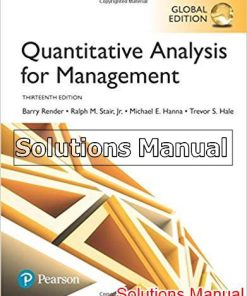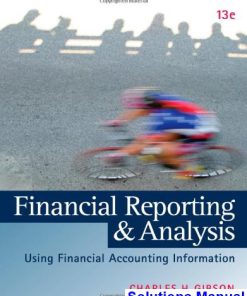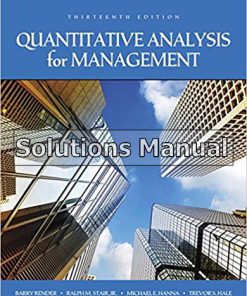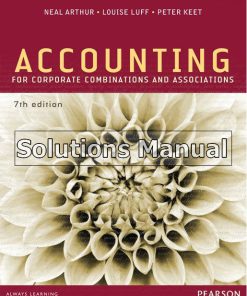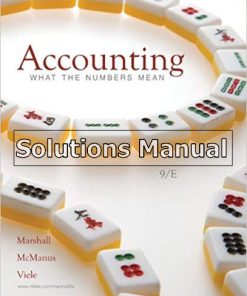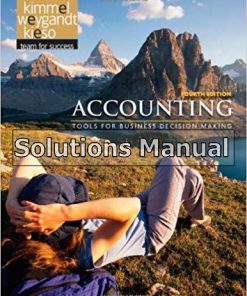Investments Analysis and Management 13th Edition Jones Solutions Manual
$26.50$50.00 (-47%)
Investments Analysis and Management 13th Edition Jones Solutions Manual.
You may also like
Investments Analysis and Management 13th Edition Jones Solutions Manual

Product details:
- ISBN-10 : 1118975588
- ISBN-13 : 978-1118975589
- Author: Charles P. Jones
In an every-changing financial market, Charles Jones and Gerald Jensens’ Investments remains one of the most readable and comprehensive investments texts. Students can count on the new 13th Edition for clarity, currency, and balance. An effective organizational structure and essentials approach, important analytical methods, and finance concepts are presented at a level that individuals of all investments backgrounds can master.
Table contents:
- Part One: Background
- Chapter 1: Understanding Investments
- An Overall Perspective on Investing
- Establishing a Framework for Investing
- Some Definitions
- A Perspective on Investing
- Why Do We Invest?
- Take a Portfolio Perspective
- The Importance of Studying Investments
- The Personal Aspects
- Investments As a Profession
- Understanding the Investment Decision Process
- The Basis of Investment Decisions—Return and Risk
- Checking Your Understanding
- Structuring the Decision Process
- Important Considerations in the Investment Decision-Making Process
- The Great Unknown
- A Global Perspective
- The Importance of the Internet
- Individual Investors versus Institutional Investors
- Ethics in Investing
- Checking Your Understanding
- Organizing the Text
- Summary
- Questions
- Spreadsheet Exercises
- Checking Your Understanding
- Chapter 2: Investment Alternatives
- Organizing Financial Assets
- Direct Investing
- A Global Perspective
- Nonmarketable Financial Assets
- Money Market Securities
- The Treasury Bill
- Money Market Rates
- Checking Your Understanding
- Capital Market Securities
- Fixed-Income Securities
- Bonds
- Types of Bonds
- Government Agency Securities
- Returns on Fixed-Income Securities
- Checking Your Understanding
- Equity Securities
- Preferred Stock
- Common Stock
- Investing Globally in Equities
- Checking Your Understanding
- Private Equity
- Derivative Securities
- Options
- Futures Contracts
- A Final Note
- Summary
- Questions
- Problems
- Spreadsheet Exercises
- Checking Your Understanding
- Chapter 3: Indirect Investing
- Investing Indirectly
- What Is an Investment Company?
- How Important are Investment Companies to Investors?
- Three Major Types of Investment Companies
- Closed-End Investment Companies
- Exchange-Traded Funds (ETFs)
- ETFs Versus ETNs
- Mutual Funds (Open-End Investment Companies)
- Checking Your Understanding
- Types of Mutual Funds
- Money Market Funds
- Equity Funds, Bond Funds
- Checking Your Understanding
- The Net Asset Value per Share
- The Details of Indirect Investing
- Closed-End Funds
- Mutual Funds
- Investing in Index Mutual Funds Versus ETFs
- Weighting Methods for Index Funds
- Checking Your Understanding
- Investment Company Performance
- Measures of Fund Performance
- Morningstar Ratings
- Benchmarks
- Fund Performance and Expenses
- Some Conclusions about Fund Performance
- Investing Internationally through Investment Companies
- Fund Categories for International Investing
- The Future of Indirect Investing
- Fund Supermarkets
- Hedge Funds
- Summary
- Questions
- Computational Problems
- Spreadsheet Exercises
- Checking Your Understanding
- Chapter 4: Securities Markets and Market Indexes
- The Importance of Financial Markets
- The Primary Markets
- Initial Public Offerings (IPOs)
- The Investment Banker
- A Global Perspective
- Checking Your Understanding
- The Secondary Markets
- U.S. Securities Markets for the Trading of Equities
- The New York Stock Exchange
- The NASDAQ Stock Market
- NYSE Versus NASDAQ
- The OTC (Over-the-Counter) Market
- BATS
- Electronic Communication Networks (ECNs)
- Foreign Markets
- Checking Your Understanding
- Stock Market Indexes
- The Dow Jones Averages
- Standard & Poor’s Stock Price Indexes
- Understanding a Capitalization-Weighted Index
- NASDAQ Indexes
- Other Indexes
- Using the Correct Domestic Stock Indexes
- Foreign Stock Market Indicators
- Checking Your Understanding
- Bond Markets
- Individual Investors and Bond Trading
- Derivatives Markets
- The Globalization of Markets
- Summary
- Questions
- Problems
- Computational Problems
- Spreadsheet Exercises
- Checking Your Understanding
- Chapter 5: How Securities are Traded
- Introduction
- Brokerage Transactions
- Brokerage Firms
- Brokerage Accounts
- How Orders Work
- Trading on Today’s Exchanges
- Orders in the NASDAQ Stock Market
- Modern-Day Trading
- Types of Orders
- Clearing Procedures
- Checking Your Understanding
- Investor Protection in the Securities Markets
- Government Regulation
- Self-Regulation
- Other Investor Protections
- Checking Your Understanding
- Margin
- How Margin Accounts can be Used
- Margin Requirements and Obligations
- Margin Requirements on Other Securities
- Some Misconceptions about Margin
- Short Sales
- Selling Short as an Investor
- Checking Your Understanding
- Summary
- Questions
- Problems
- Computational Problems
- Spreadsheet Exercises
- Checking Your Understanding
- Part Two: Portfolio and Capital Market Theory
- Chapter 6: The Returns and Risks from Investing
- An Overview
- Return
- The Two Components of Asset Returns
- Measuring Returns
- Total Return
- Cumulative Wealth Index
- A Global Perspective
- International Returns and Currency Risk
- Checking Your Understanding
- Summary Statistics for Returns
- Arithmetic Mean
- Geometric Mean
- Arithmetic Mean versus Geometric Mean
- Inflation-Adjusted Returns
- Checking Your Understanding
- Risk
- Sources of Risk
- Measuring Risk
- Variance and Standard Deviation
- Risk Premiums
- Checking Your Understanding
- Realized Returns and Risks from Investing
- Total Returns and Standard Deviations for the Major Financial Assets
- Cumulative Wealth Indexes
- Understanding Cumulative Wealth as Investors
- Compounding and Discounting
- Summary
- Questions
- Demonstration Problems
- Problems
- Computational Problems
- Spreadsheet Exercises
- Checking Your Understanding
- Chapter 7: Portfolio Theory
- Dealing with Uncertainty
- Using Probabilities
- Probability Distributions
- Calculating Expected Return for a Security
- Calculating Risk for a Security
- Checking Your Understanding
- Introduction to Modern Portfolio Theory
- Portfolio Return and Risk
- Portfolio Expected Return
- Portfolio Risk
- Analyzing Portfolio Risk
- Risk Reduction—The Insurance Principle
- Diversification
- Checking Your Understanding
- The Components of Portfolio Risk
- Covariance
- The Correlation Coefficient
- Checking Your Understanding
- Calculating Portfolio Risk
- The Two-Security Case
- The n-Security Case
- Checking Your Understanding
- Obtaining the Data
- Simplifying the Markowitz Calculations
- Summary
- Questions
- Problems
- Computational Problems
- Spreadsheet Exercises
- Checking Your Understanding
- Chapter 8: Portfolio Selection and Asset Allocation
- Building a Portfolio Using Markowitz Principles
- Identify Optimal Risk–Return Combinations
- The Attainable Set of Portfolios
- Selecting an Optimal Portfolio of Risky Assets
- The Global Perspective—International Diversification
- Some Important Conclusions about the Markowitz Model
- Checking Your Understanding
- Selecting Optimal Asset Classes—The Asset Allocation Decision
- Asset Allocation and Diversification
- Some Major Asset Classes
- Combining Asset Classes
- Asset Allocation and the Individual Investor
- Life-Cycle Analysis
- Other Approaches
- Checking Your Understanding
- The Impact of Diversification on Risk
- Systematic and Nonsystematic Risk
- How Many Securities are Needed to Fully Diversify?
- The Implications of Reducing Risk by Holding Portfolios
- Summary
- Questions
- Problems
- Spreadsheet Exercises
- Checking Your Understanding
- Chapter 9: Capital Market Theory and Asset Pricing Models
- Capital Market Theory
- Capital Market Theory Assumptions
- Introduction of the Risk-Free Asset
- Risk-Free Borrowing and Lending
- Checking Your Understanding
- The Capital Market Line
- Defining The Capital Market Line
- The Separation Theorem
- Understanding the CML
- The Equation for the CML
- Important Points about the CML
- Checking Your Understanding
- Systematic Risk and Beta
- Above- and Below-Average Beta Stocks
- In Summary, What is Beta?
- Estimating Beta
- The Capital Asset Pricing Model (CAPM)
- Checking Your Understanding
- Implementing the CAPM
- Tests of CAPM
- Arbitrage Pricing Theory
- The Law of One Price
- Assumptions of APT
- Factor Models
- Understanding the APT Model
- Identifying the Factors
- Using APT in Investment Decisions
- Checking Your Understanding
- Other Prominent Factor Models
- Some Conclusions about Asset Pricing
- Summary
- Questions
- Demonstration Problems
- Problems
- Computational Problems
- Spreadsheet Exercises
- Checking Your Understanding
- Part Three: Common Stocks: Analysis, Valuation, and Management
- Chapter 10: Common Stock Valuation
- Overview
- Discounted Cash Flow Models
- Two Broad DCF Approaches
- The Dividend Discount Model
- Applying the DDM
- The DDM Equation
- Implementing the DDM
- Estimating Future Dividends
- Checking Your Understanding
- Growth Rate Cases for the DDM
- The Zero-Growth Rate Model
- The Constant-Growth Rate Model
- How k and g Affect Value
- The Multiple-Growth Rate Model
- Dividends, Dividends—What about Capital Gains?
- The Dividend Discount Model in Practice
- Checking Your Understanding
- Other Discounted Cash Flow Approaches
- Free Cash Flow to Equity
- Free Cash Flow to the Firm
- Intrinsic Value and Market Price
- Checking Your Understanding
- The Multiplier Approach
- Earnings Multiplier (P/E Ratio)
- Other Multipliers
- Price to Book (P/B)
- Price to Sales (P/S)
- Price to Cash Flow (P/CF)
- Enterprise Value To EBITDA (EV/EBITDA)
- Relative Valuation Metrics
- Price/Earnings (P/E) Ratio
- Price/Book (P/B) Ratio
- Price/Sales (P/S) Ratio
- Price/Cash Flow (P/CF) Ratio
- Enterprise Value/EBITDA (EV/EBITDA) Ratio
- Economic Value Added Analysis
- Which Approach To Use?
- Bursting the Bubble on New Economy Stocks—A Lesson in Valuation
- Checking Your Understanding
- Some Final Thoughts on Valuation
- Summary
- Questions
- Demonstration Problems
- Problems
- Computational Problems
- Spreadsheet Exercises
- Checking Your Understanding
- Chapter 11: Common Stocks: Analysis and Strategy
- A Global Perspective
- The Impact of the Overall Market on Stocks
- Building Stock Portfolios
- Checking Your Understanding
- The Passive Strategy
- Buy-and-Hold Strategy
- Index Funds
- Checking Your Understanding
- The Active Strategy
- Security Selection
- Rotation Strategies
- Market Timing
- Checking Your Understanding
- Rational Markets and Active Strategies
- A Simple Strategy: The Coffeehouse Portfolio
- Summary
- Questions
- Problems
- Computational Problems
- Spreadsheet Exercises
- Checking Your Understanding
- Chapter 12: Market Efficiency
- Overview
- The Concept of an Efficient Market
- What Is an Efficient Market?
- Why the U.S. Stock Market Can Be Expected to Be Efficient
- The International Perspective
- Forms of Market Efficiency
- Checking Your Understanding
- How to Test for Market Efficiency
- Weak-Form Tests
- Semistrong-Form Tests
- Strong-Form Evidence
- Checking Your Understanding
- Market Anomalies
- Earnings Announcements
- Low Price Multiples
- The Size Effect
- The January Effect
- Past Stock Return Performance
- The Value Line Ranking System
- Other Anomalies
- Data Mining
- Checking Your Understanding
- Behavioral Finance
- Efficient Markets versus Behavioral Finance
- Behavioral Finance Implications for Investors
- Behavioral Finance Today
- Checking Your Understanding
- Some Conclusions about Market Efficiency
- Summary
- Questions
- Problems
- Checking Your Understanding
- Part Four: Security Analysis
- Chapter 13: Economy/Market Analysis
- Introduction
- Taking a Global Perspective
- Assessing the Economy
- The Business Cycle
- Forecasts of the Economy
- Checking Your Understanding
- The Stock Market and the Economy
- The Economy and Stock Market Booms
- Economic Slowdowns and Bear Markets
- Checking Your Understanding
- Understanding the Stock Market
- A Model of Aggregate Stock Prices
- Checking Your Understanding
- Making Market Forecasts
- Focus on the Important Variables
- Checking Your Understanding
- Using the Business Cycle to Make Market Forecasts
- The E/P Ratio and the Treasury Bond Yield
- Summary
- Questions
- Problems
- Computational Problems
- Spreadsheet Exercises
- Checking Your Understanding
- Chapter 14: Sector/Industry Analysis
- Introduction
- What Is an Industry?
- Classifying Industries
- The NAICS Classification System
- Other Industry Classifications
- The Importance of Sector/Industry Analysis
- Why Sector/Industry Analysis Is Important over the Long Run
- Checking Your Understanding
- Sector Performance over Shorter Periods
- How One Industry can Have a Major Impact on Investors: The Telecom Industry
- Cross-Sectional Volatility Has Increased
- Analyzing Sectors/Industries
- The Industry Life Cycle
- Checking Your Understanding
- Qualitative Aspects of Industry Analysis
- Using Sector/Industry Analysis as an Investor
- Assess the Business Cycle
- Review Investment Advisory Services about Industries
- Sector Rotation
- Evaluating Future Industry Prospects
- Summary
- Questions
- Checking Your Understanding
- Chapter 15: Company Analysis
- Fundamental Analysis
- The Accounting Aspects of Earnings
- The Financial Statements
- Checking Your Understanding
- The Problems with EPS
- Reported Earnings
- Has the Situation Improved?
- Checking Your Understanding
- Using the Financial Statements to Analyze a Company’s FCF, ROE, and EPS
- Analyzing Free Cash Flow (FCF)
- Analyzing Return on Assets (ROA)
- Analyzing Return on Equity (ROE)
- The Accounting Determinants of EPS
- Estimating the Internal (Sustainable) Growth Rate
- Checking Your Understanding
- Earnings Estimates
- A Forecast of EPS
- The Accuracy of Earnings Forecasts
- Earnings Surprises
- Earnings Guidance
- The Earnings Game
- Useful Information for Investors about Earnings Estimates
- Alternatives to Earnings
- The Multiplier
- The P/E Ratio
- Determinants of the P/E Ratio
- Determinants of the P/B Ratio
- Determinants of the P/S Ratio
- Why Price Multiples Vary among Companies
- The PEG Ratio
- Fundamental Security Analysis in Practice
- Summary
- Questions
- Problems
- Computational Problems
- Spreadsheet Exercises
- Checking Your Understanding
- Chapter 16: Technical Analysis
- Introduction
- What Is Technical Analysis?
- A Framework for Technical Analysis
- Checking Your Understanding
- Stock Price and Volume Techniques
- The Dow Theory
- Charts of Price Patterns
- Checking Your Understanding
- Moving Averages
- Relative Strength
- Using the Computer for Technical Analysis
- Technical Indicators
- Breadth Indicators
- Sentiment Indicators
- Testing Technical Analysis Strategies
- The Ebb and Flow of Technical Analysis
- Some Conclusions about Technical Analysis
- Summary
- Questions
- Computational Problems
- Checking Your Understanding
- Part Five: Fixed-Income Securities: Analysis, Valuation, and Management
- Chapter 17: Bond Yields and Prices
- Introduction
- Bond Yields and Interest Rates
- The Basic Components of Interest Rates
- The Term Structure of Interest Rates
- Risk Premiums (Yield Spreads)
- Measuring Bond Yields
- Current Yield
- Yield to Maturity
- Yield to First Call
- Realized Compound Yield
- Checking Your Understanding
- Checking Your Understanding
- Bond Prices
- The Valuation Principle
- Bond Valuation
- Bond Price Changes
- Bond Price Changes over Time
- Bond Price Changes As a Result of Interest Rate Changes
- Checking Your Understanding
- Summary
- Questions
- Problems
- Computational Problems
- Spreadsheet Exercises
- Checking Your Understanding
- Chapter 18: Bonds: Analysis and Strategy
- Why Buy Bonds?
- Buying Foreign Bonds
- Important Considerations in Managing a Bond Portfolio
- Understanding the Bond Market
- Global Factors and the U.S. Bond Markets
- Checking Your Understanding
- Bond Strategies and Techniques
- Passive Management Strategies
- Buy and Hold
- Indexing
- Active Management Strategies
- Forecasting Changes in Interest Rates
- Yield Spread Analysis
- Identifying Mispricing among Bonds
- New Tools for Individual Investors
- Managing Price Volatility
- Duration
- Checking Your Understanding
- Managing Price Volatility
- Immunization
- Summary
- Questions
- Problems
- Computational Problems
- Spreadsheet Exercises
- Checking Your Understanding
- Part Six: Derivative Securities
- Chapter 19: Options
- Why Have Derivative Securities?
- Why Options Markets?
- Introduction to Options
- Long-Term Options
- WeeklysSM Options
- Understanding Options
- Options Terminology
- Checking Your Understanding
- How Options Work
- The Mechanics of Trading
- Checking Your Understanding
- Payoffs and Profits from Basic Option Positions
- Calls
- Puts
- Some Basic Options Strategies
- Covered Calls
- Protective Puts
- Portfolio Insurance
- Checking Your Understanding
- Option Valuation
- A General Framework
- Intrinsic Values and Time Values
- Boundaries on Option Prices
- The Black–Scholes Model
- Put Option Valuation
- Summarizing the Factors Affecting Options Prices
- Hedge Ratios
- Using the Black–Scholes Model
- Checking Your Understanding
- An Investor’s Perspective on Puts and Calls
- What Puts and Calls Mean to Investors
- The Evolutionary Use of Options
- Stock Index Options
- The Basics of Stock Index Options
- Strategies with Stock Index Options
- The Popularity of Stock Index Options
- Summary
- Questions
- Problems
- Computational Problems
- Spreadsheet Exercises
- Checking Your Understanding
- Chapter 20: Futures Contracts
- An Overview of Futures Markets
- Why Futures Markets?
- What Is Traded in the Futures Markets?
- The Structure of Futures Markets
- U.S. Futures Exchanges
- Foreign Futures Markets
- The Clearinghouse
- Checking Your Understanding
- The Mechanics of Trading
- Futures Contracts
- Basic Procedures
- Margin
- Checking Your Understanding
- Using Futures Contracts
- Hedgers
- How to Hedge with Futures
- Speculators
- Calculating Rate of Return on Futures Contracts
- Checking Your Understanding
- Financial Futures
- Foreign Currency Futures
- Interest Rate Futures
- Stock-Index Futures
- Single Stock Futures
- Summary
- Questions
- Problems
- Computational Problems
- Checking Your Understanding
- Part Seven: Investment Management
- Chapter 21: Managing Your Financial Assets
- A Perspective on Investing in Financial Assets
- Managing Your Financial Assets
- Individual Investors Vary Widely
- Checking Your Understanding
- Formulate an Appropriate Investment Strategy
- Investor Objectives
- Assessing Your Risk Tolerance
- Establishing Your Return Expectations
- Checking Your Understanding
- What Issues Do Investors Face in Their Financial Planning?
- Liquidity Needs
- Time Horizon
- Tax Considerations
- Regulations
- Unique Individual Circumstances
- Investor Expectations as a Part of Financial Planning
- Rate of Return Assumptions
- Checking Your Understanding
- Implementing Investing Strategies
- Asset Allocation
- Portfolio Optimization
- Basic Investment Management Strategies
- Financial Planning on an Ongoing Basis
- Tax-Advantaged Investing
- Monitoring Market Conditions
- Checking Your Understanding
- Rebalancing a Portfolio of Financial Assets
- Determining the Success of Your Financial Planning
- Summary
- Questions
- Spreadsheet Exercises
- Checking Your Understanding
- Chapter 22: Evaluation of Investment Performance
- A Framework for Evaluating and Assessing Portfolio Performance
- Performance Measurement Issues
- Three Questions to Answer in Measuring Portfolio Performance
- Return Calculations
- Risk Considerations
- Checking Your Understanding
- Performance Benchmarks and Performance Universes
- Performance Universes
- Performance Benchmarks
- A Straightforward Approach to Performance Evaluation
- Risk-Adjusted Measures of Performance
- The Sharpe Ratio
- Treynor’s Reward to Volatility
- Checking Your Understanding
- Jensen’s Alpha
- Information Ratio
- M2
- Sortino Ratio
- Checking Your Understanding
- Style Analysis and Performance Attribution
- Style Analysis
- Performance Attribution
- Money Managers and Performance Presentations
- Checking Your Understanding
- An Overview on Performance Evaluation
- Summary
- Questions
- Problems
- Computational Problems
- Spreadsheet Exercises
- Checking Your Understanding
- Glossary
- Index
- EULA
People also search:
investments analysis and management 13th edition
what is investment analysis and portfolio management
investments analysis and management 14th edition pdf
investments analysis and management 14th edition
investments analysis and management


